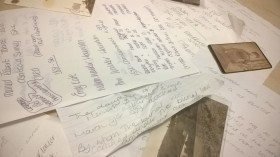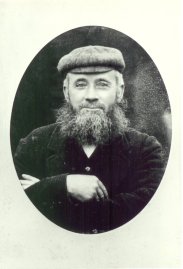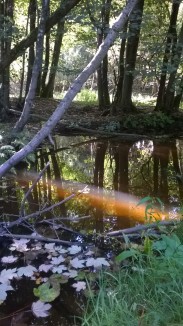
For some strange reason, it didn’t occur to me when I purchased this photograph that there could possibly be more than one Edgar Lambert around in 1895. And it wasn’t until I got home and actually looked more closely at it, that I noticed there were no studio details on it either to give me a clue as to his location in 1895. A search of the 1891 census gave me about 5 possible Edgars aged between 19 and 36. So with just a name and a date it looked like, on this occasion, I could go no further.
But.
I don’t like to give up quite so easily.
While I was looking more closely at the photo I began to wonder if Mr Lambert was perhaps a clergyman? he was wearing what looked like a white collar. I emailed the photo to my mum to get a second opinion. Well, she thought he looked like a sailor.
Back I went to the 1891 census, and looked again at my collection of Edgars. And one of those Edgars was a Church of England Minister, living with his wife Norah and 10 month old son Joseph, at his fathers home in Yorkshire. Could this be him?
Now, even though I was feeling just a teensy bit pleased with myself, I had to try and confirm that it was the same Edgar from my photo. So I began a long search for information about Edgar online and eventually I found this photo, which when I compared it to mine, confirmed I had the correct Edgar albeit about 15 years older.

He has the same swept back hair, a moustache and has gained a beard and a bit of distinguishing grey. “And the same ears.” said my helpful mum, who had been kind of right about him being a sailor as we shall see, but don’t tell her. Confident I had found the correct man, I began to find out a bit about him.
Photograph courtesy of Maritime Views
Edgar was born in Hull, Yorkshire on the 22nd of November 1858, the son of Joseph Lambert and his second wife Jane Hudson Malet. Joseph was a successful Commercial Agent and, in later years, Justice of the Peace for the East Riding area of Yorkshire.
On the 7th of January 1859, just a few weeks after her sons birth, Jane died aged just 32, leaving behind 5 young children. Edgars baptism was delayed and took place in April.
Joseph Lambert married again in 1861 and went on to have a further 8 children by his new wife Rachel.
By 1871 Edgar, along with an older brother Frank, was a student boarding at college in Cheltenham before entering Pembroke College, part of Cambridge University.
I found Edgar in Mortlake, Surrey in the 1881 census, where he is listed as a 22 year old undergraduate of Cambridge University. I discovered he was there with his fellow university crew mates in preparation for the 38th Cambridge and Oxford Boat Race which took place on the 8th of April, 5 days after the census was taken.
Sadly Edgars team lost. He was not put off by this though as he returned again the following year to have another attempt. He was, by all accounts, a very talented rower and served as President to Cambridge University Boat Club while he was a student.
Edgar left his rowing behind in 1883 when he was ordained into the Church. Although entering the Church was always going to be a possibility (his oldest brother Joseph and an uncle had already joined the church) Edgars love of boating must have had some influence on his choice of career, because after he was ordained in 1883 almost straight away He became ‘Chaplain to Seaman’ in Sunderland.
As a member of the Missions to Seaman, Edgar would have visited crew on board ships anchored out at sea and at the dockside to provide pastoral care to those sailors who were unable to attend church. The organisation also provided affordable accommodation, food and company for those sailors who were without work or perhaps a long way from home and between ships as well as regular church services in its chapel.
On the 17th of July 1889 Edgar married Norah Tuke Taylor, and the couple moved into Joseph Lambert Snrs home in Cottingham, Yorkshire – which of course is where I found them in 1891. Shortly after the birth of their second child, Edgar was offered and accepted the position of Rector in Heene, Sussex a few miles along the coast from Brighton.
The move would have been a major upheaval. Heene is over 250 miles from Cottingham and the family would probably have travelled by steam train to their destination. Hopefully the Rectory would have been fully furnished for the family. But even with two young children, a couple of servants and a huge amount of luggage, as well as some mementos from home, it would have have been a long and tiring journey.
By the spring of 1892 the Lamberts were settling into their new home, and it wasn’t long before Edgar was appearing in the local papers having officiated at local weddings and funerals big and small.
But it seems he missed his previous calling. In 1895 the family moved again, this time to Liverpool where he became the Chaplain-Superintendent of the Mersey Mission to Seamen. It seems likely that this is when the photograph was taken, to mark his new position in Liverpool in 1895. Perhaps this is why he has a sailorish look about him in the picture.
Edgar remained in Liverpool until 1911 when he returned to the South. He was by now aged 52 and he became the Vicar of Wye, near Folkestone in Kent where he would remain for 15 years.
Even when he was in his late 60s he didn’t think of retirement, spending 2 years as the Chaplain at Vernet-les-Bains, a small village in the Pyrenees which had been popular with Rudyard Kipling and his wife before the Great War.
Edgar and his wife returned to England in 1928, where they lived on the south coast until their deaths, just 18 months apart.
I think a quote from the Hartlepool Northern Daily dated 11th November 1911 (probably shortly after Edgar began his work in Liverpool) should have the final word
‘……Think of Edgar Lambert, the President of the Cambridge Boat Club, who has done such noble work in the Missions to Seaman for a quarter of a century, laying down, as it has so beautifully been said, his ‘Varsity oar at his Masters feet when he spent his life as a sailor parson on the Wear.’









